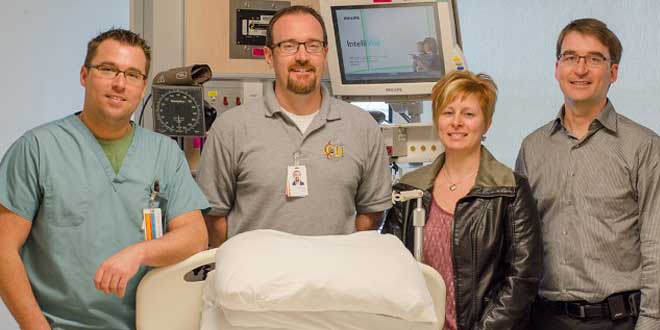North East LHIN supports project to extend care outside hospital’s intensive care unit walls
SUDBURY — A first-of-its-kind health care program will soon start right here in Northeastern Ontario to benefit Northerners needing critical care support at small rural regional hospitals.
Every hour of every day, the Virtual Critical Care Unit (VCCU) team, located at Health Sciences North (HSN) in Sudbury, will be available to provide its expertise through technology. The NE LHIN-funded project, starting in May, will extend intensive care consultation to smaller hospitals across our vast region.
“I strongly believe this is a first in Canada; it’s definitely a first in Ontario,” said Dr. Derek Manchuk, the North East LHIN’s Critical Care Lead, and the project’s lead.
“Providing quality patient care, close to home, is a priority for the North East LHIN,” said Louise Paquette, CEO, NE LHIN. “This patient-focused project is a tremendous accomplishment that has been achieved through collaboration. I commend Dr. Manchuk for his innovative thinking, and for his leadership.”
This new model of care delivery will provide a patient at a community hospital with the benefit of experts skilled in critical care, and less need to be transported away from home and family to a larger regional hospital. It has been achieved thanks to a partnership between the NE LHIN and HSN, where Dr. Manchuk also serves as Chief of the Service of Critical Care.
“HSN is very pleased and honoured to be the lead site for the new Virtual Critical Care Unit,” said Dr. Denis Roy, President and CEO of Health Sciences North/Horizon Santé-Nord. “I want to congratulate the entire ICU and IT teams at HSN, and their hospital partners in the northeast, for their stellar work in putting together this new concept in critical care. Well done!”
Dr. Manchuk has tested our Northeastern ICUs against a set of 10 provincial metrics on what the ICU should have as standards. He determined that two of our larger hospitals scored well, but many of our smaller ones are lacking human resources.
“When you survey the resources across our hospitals, there are discrepancies in what critical care is available,” said Dr. Manchuk. “This VCCU adds real value to the care of patients for the smaller hospitals in our region.”
The VCCU team includes: an Intensivist (a specialist in ICU care), a critical care pharmacist, a nurse with extra critical care training, a dietitian and a respiratory therapist. They will operate what is called a “passive model” of telemedicine, meaning that the team will respond to requests to provide consultative advice to small hospitals.
The VCCU will start in May with three hospitals — Kirkland Lake, New Liskeard and Elliot Lake. In the fall, the ERs and ICUs of five sites will be brought on-line and in early 2015, another 14 sites with emergency rooms only will be brought on board. The plan is to have all ICUs and emergency rooms in the NELHIN connected by technology to the VCCU.
Dr. Manchuk said the Ontario Telemedicine Network is a key part of the VCCU and will be used for videoconferencing. Enhancements being made to regional IT will allow hospitals to transmit diagnostic and lab results, to be read by the VCCU team.
“This is an ambitious use of telemedicine for critical care,” said Dr. Manchuk.
He recalls two examples from a project pilot that illustrate the project’s benefit. After “seeing” each of the patients using videoconferencing, the virtual critical care team was able to provide guidance to staff at a smaller hospital on mixing and administering a IV medication that Dr. Manchuk recommended for a patient with an irregular heartbeat; the other was to remove a breathing tube with the direction from the remote respiratory therapist, sparing the patient a trip to a larger hospital.
FACTS:
- Three hospitals participated in a North East LHIN pilot of this project in 2009/10. In the pilot, both referring and consulting partners indicated that they liked the approach, and it helped avoid the transfer of patients in about one-third of the cases. All thought quality was improved.
- Later this fall, the project will also include providing care to regional Emergency Rooms (ERs). Our region has 14 hospitals with ERs, but not ICUs. Dr. Manchuk said the project’s goal with ERs is to provide earlier care and to have consultations done faster.
- The Virtual Critical Care Team is from Health Sciences North, Sudbury.
FOR MORE INFORMATION: Kathleen Bain, communications officer with the North East LHIN at 705-840-2340, or kathleen.bain@lhins.on.ca





